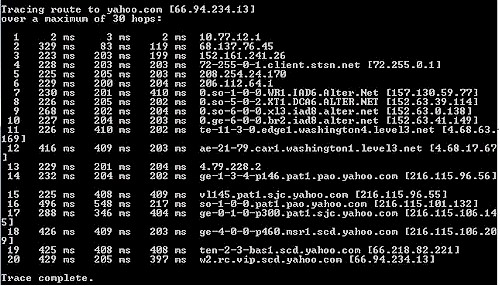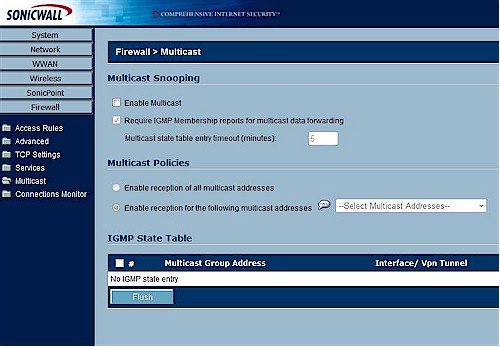I’ve covered some of the basic elements of Multicasting, such as IGMP and the Layer 2 switching components in my previous posts (Part 2). This article will go into the technology behind Multicasts at Layer 3 and some of the issues limiting wider use of Multicast technology.
As you recall in my first post, I observed that Yahoo’s transmissions of live NHL games would seem to be good candidates for Multicast, yet were being sent as unicast. Then I covered the simple issue of enabling Multicast within a local area network. Coming full circle, here we are diving into Multicast technology to understand why it isn’t more widespread.
At the source of a Multicast transmission is a multimedia device blindly sending the data stream. At the receiving end of the Multicast transmission is a user’s PC attempting to listen or watch the data stream. In between are numerous routers that must forward the data stream from the source, possibly replicating the data stream out multiple interfaces, and supporting a variety of different protocols and configurations.
Multicast packets aren’t routed from a source to a destination like unicast packets. Multicast source devices blindly transmit a data stream from their Source IP address to the Group IP addresses as discussed in my last post. This addressing is often referred to by the notation (S,G).
Receivers connect to Multicasts via IGMP to join messages sent upstream. Connecting the routers between the source and receivers involves various Multicast tree and mode technologies, including shared and source based trees, as well as dense and sparse mode routing. Protocol Independent Multicast, or PIM, is a more common routing protocol used to connect the routers to form the router tree from the source to the destinations.
The state of the connections between the source and receivers must be tracked and managed for the duration of each Multicast. A simple traceroute to Yahoo.com originated from my PC here on the east coast reveals 20 different routers are traversed to get to a Yahoo server (Figure 1).

Figure 1: Traceroute to Yahoo
In the event of a Multicast from Yahoo to my PC, and assuming I wasn’t the only viewer, potentially every one of those 20 routers would have to track which interfaces have interested receivers for as long as there was one viewer downstream from that interface.
Imagine then that there were more Multicasts then just NHL games. All these Multicasts would have to be tracked in real time by multiple routers, and allow for dynamic joining and leaving by viewers. If enabled for general use by senders and receivers, this continuous tracking and management of replication, sources and receivers would add a huge amount of overhead on the infrastructure routers in ISP networks.
In fact, most major ISPs do not support Multicast for reasons including the technical challenges discussed. The list of major networks that support Multicast is pretty short, and doesn’t include any of the major telephone companies or cable companies. There are simple tools available to check to see if your ISP supports Multicast, such as the html based application provided by Multicast Technology. I suspect there are economic reasons as well, as ISPs who are also in the entertainment business may be hesitant to facilitate competing media over their networks.
Public Multicast networks do exist, such as the Mbone, an open network designed to support and carry Multicast traffic. Other networks may exist, but check them first if WAN Multicasts are important to your network.
Although limited over the Internet, Multicasts are a viable technology on corporate networks, often used for transmitting audio and video messages. Having all the routers under the control of a single entity makes it easier to ensure consistency of configuration and control of Multicast sources and resource utilization.
In a smaller network, gateway routers may support Multicasting in some form. For example, Figure 2 shows the configuration options in the SonicWall TZ190 [reviewed] to enable support for Multicast transmissions.

Figure 2: Enabling IGMP Snooping – Linksys SRW2008
At the end of the day, what does this mean for Multicasting on the small network? At the switching layer, all switches will forward Multicast frames. More advanced switches can be configured to limit the Multicast to just the ports with interested receivers. This is useful to manage the bandwidth on your LAN, with the cost being greater CPU utilization of your switch.
At the routing layer, most small network routers are gateway routers with only two routable interfaces, one for the WAN and the other for the LAN. (Note that the LAN interface on most gateway routers has multiple switched ports, but those ports all appear as a single routable interface.) For these common routers, enabling Multicast is done by allowing IGMP packets through the Firewall as in the above SonicWall example.
Within a larger private network, Multicasting is a good solution for transmitting media streams to multiple receivers, assuming each of the routers and switches support IGMP and Multicast routing. With all the devices are under your control, Multicast technology is an efficient means to transmit real time multimedia data streams while maximizing network bandwidth.
Note that Multicast is a technology used for live, real-time transmission of a multimedia stream. Sources like You Tube are multimedia, but typically are pre-recorded and are more often unicast.
The bottom line is that Multicast is a technology that has merit, but due to complexities with varying interoperability, scaling and business issues, isn’t as utilized over public networks as it could be. For the most part, Multicasting over public networks is out of the control of the typical network administrator. To get your ISP to support Multicasting, there may be options they offer, they may be open to a request to support Multicasting, or you may need to consider another ISP.
Going forward, expect to see more of Multicast technology as competition, demand, and protocol enhancements drive more networks to support multimedia data flows. As more live entertainment is streamed real-time over the Internet, more ISPs will move to Multicast technology to conserve bandwidth over core networks. Further, as improvements to Multicasting technology are adopted, such as IGMPv3 and IPV6, the issues limiting Multicast will diminish.
